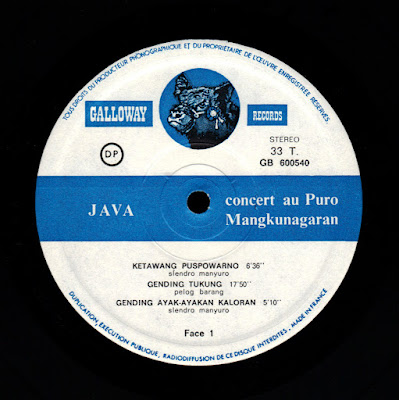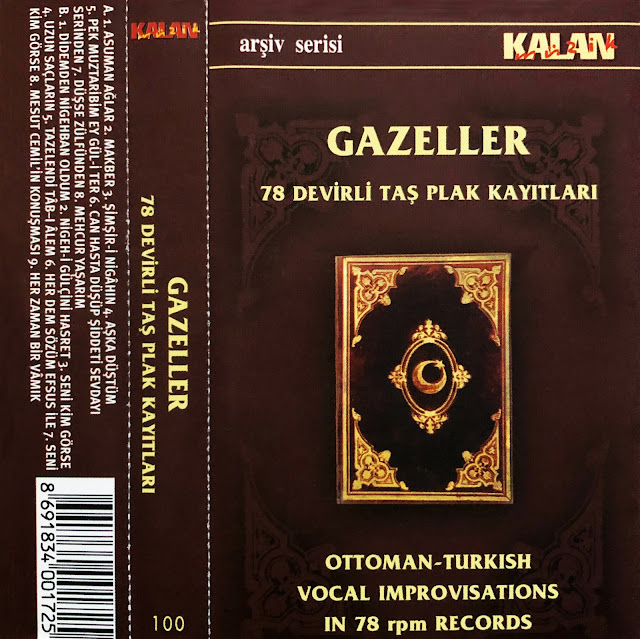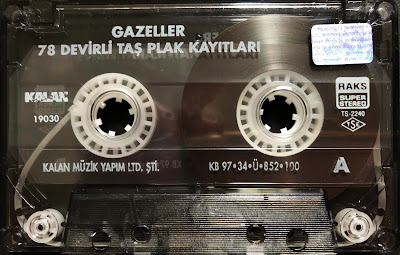Omkarnath Thakur – Amar Woh Desh & Re Din Kaise Kate Re (Kabir Bhajans) – SEDE 3302 COLUMBIA – (Vinyl 7 inch, 45 RPM)
Omkarnath Thakur (1897-1967) was a major 20th century Hindustani vocalist, teacher and musicologist. Though born into a military family in the village of Jahaj, Gujarat State, his father, Gauri Shankar Thakur, had withdrawn from the world after meeting a holy man and dedicating his life to meditation and spirituality until his death in 1910. Because of his father's asceticism, Omkarnath's childhood was one of privation and poverty. But at the age of 12, a philanthropist from Bharuch recognized Thakur’s rare musical gifts and paid for him to enroll in the Vishnu Digambar Paluskar Music School in Mumbai in 1909. While studying here, Vishnu Digambar Paluskar (1872-1931), a great master of the Gwalior Gharana and renaissance man who pioneered the popularization of classical and devotional music among the masses, took Thakur under his wing and appointed him principal of a newly opened branch of his music school in Lahore, Pakistan, at the age of 20. Thakur later became the first dean at the music faculty at Bānaras (or Vārānasi) Hindu University when it opened in 1950.
Thakur often accompanied Paluskar onstage during Paluskar's many concert tours and began performing solo. By the late 1920s he had achieved national fame and became a major fixture on the Indian classical music scene. When Thakur toured Europe in 1933, he also became one of the first Indian musicians to both perform and lecture there.
That same year, Thakur's wife, Indira Devi, died in childbirth. This loss grieved him so deeply that he never remarried. “My favorite deity is Lord Rama. Like Him, I believe that each man should marry only once in his lifetime and cherish her throughout life,” he once said.* He devoted himself entirely to his music and students.
According to Deepak S. Raja, "There are clearly three facets to Omkarnath’s personality as a musician. The first is his preoccupation with the mystical aspects of musical pursuits, inherited from his father, who renounced the world to unravel the mysteries of the primal sound, ‘Om.’ The second is the scholarly facet, steeped in ancient musicological texts, whose wisdom he attempted to translate into performance. The third is the dramatic, even theatrical, facet that explicitly sought to create an impact among his audiences … The combination, however, made him a colorful and even controversial musician.”** Although Thakur crafted his own idiosyncratic style, he achieved great popular appeal and brilliantly championed Paluskar’s lofty goal of popularizing Indian classical music.
On this 7-inch record, Thakur performs two bajhans by the 15th-century mystic, poet and musician Kabir Das, showcasing his masterful mellifluous singing interspersed with creative and dynamic vocal ornamentation.
Omkarnath Thakur (1897-1967) fut un chanteur, professeur et musicologue hindoustani majeur du XXe siècle. Bien que né dans une famille militaire du village de Jahaj, dans l'État du Gujarat, son père, Gauri Shankar Thakur, s'était retiré du monde après avoir rencontré un saint homme et consacré sa vie à la méditation et à la spiritualité jusqu'à sa mort en 1910. l'ascèse, l'enfance d'Omkarnath fut marquée par les privations et la pauvreté. Mais à l'âge de 12 ans, un philanthrope de Bharuch reconnu les dons musicaux prodigieux d’Omkarnath Thakur et l’aida a s'inscrire à l'école de musique Vishnu Digambar Paluskar à Mumbai en 1909. Le grand maître du Gwalior Gharana Vishnu Digambar Paluskar (1872-1931), qui fut un visionnaire qui s’évertua à diffuser la musique classique et dévotionnelle auprès du plus grand nombre, pris Thakur sous son aile et le nomme directeur de sa nouvelle son école de musique à Lahore, au Pakistan, alors que celui-ci n’a que 20 ans ! Thakur deviendra également le premier doyen de la faculté de musique de l'Université hindoue de Bānaras (ou Vārānasi) lors de son ouverture en 1950.
Thakur accompagna fréquemment Paluskar sur scène lors de ses nombreuses tournées et commença à se produire en solo. À la fin des années 1920, Paluskar avait acquis une renommée nationale et était devenu un artiste incontournable de la scène musicale classique indienne. Lorsque Thakur fit une tournée en Europe en 1933, il devint également un des premiers musiciens indiens à y jouer et à y donner des conférences.
Cette même année, la femme de Thakur, Indira Devi, meurt lors d’un accouchement. Cette perte le marqua profondément et il ne se remarie pas. "Ma divinité préférée est le Seigneur Rama. Comme lui, je crois que chaque homme ne devrait se marier qu'une seule fois dans sa vie et chérir sa femme toute sa vie », a-t-il dit un jour.* Il se consacra entièrement à sa musique et à ses élèves.
Selon Deepak S. Raja, « En tant que musicien, om distingue clairement trois facettes dans la personnalité d'Omkarnath. La première est l’importance accordée aux aspects mystiques de la musique, héritée de son père, qui renonça au monde, afin de percer les mystères du son primordial, ‘Om’. La seconde est la facette universitaire, imprégnée d’anciens textes musicologiques, dont il tenta de traduire la sagesse lors de ses récitals. La troisième facette est l’introduction d’éléments dramatiques, voire théâtraux, qui visaient explicitement à créer un impact auprès de son public… Cette combinaison originale a fait de lui un musicien haut en couleur et même controversé. »** Bien que Thakur développa son propre style idiosyncratique, il fut extrêmement populaire et respecté de son vivant et poursuivi brillamment le noble objectif de son maître V.D. Paluskar de populariser la musique classique indienne.
Sur ce disque 45 tours, Thakur interprète deux bajhans du mystique, poète et musicien du XVe siècle Kabir Das, avec son chant magistral mélodieux agrémenté d'ornementations vocales créatives et dynamiques.
*Susheela Misra’s Great Masters of Hindustani Music (1981).
**http://swaratala.blogspot.com/2011/06/pandit-omkarnath-thakur-1897-1967.html
Swami Haridasa with Tansen and Akbar at Vrindavana, Kishangarh, Rajasthan, c. 1760, National Museum, New Delhi:
Swami Haridasa, a singer and poet of high order, is seated in his hermitage at Vrindavana.The place is a quiet one and suited best to one’s absorption in a musical performance. Swami Haridasa is holding a tambura in his hands and is engrossed in his divine music. Tansen, a disciple of Haridasa, is seated at a little distance, facing him. Mughal emperor Akbar is hiding himself behind a grove of banana trees.
It is said that Akbar, the Mughal Emperor, once asked Tansen if his guru would come to his court. Tansen replied that his guru would not oblige the great king. Akbar then decided to visit Swami Haridasa at Vrindavana and enjoyed the music of this great saint-musician.
After his return to Agra he asked Tansen why in his music the melodious touch was missing which was there in his guru’s melody. To this, Tansen replied, 'I sing for the king of the country while Swami Haridasa does it for the king of kings, the Almighty, hence the difference.'”
Stories from National Museum - New Delhi:
Please help me purchase important traditional records to pursue my global
curation project and share the best finds with you on this blog:

%200%2042.jpg)
%200%2031.jpg)

%20-23%2058.jpg)
%204%2059.jpg)
%20-18%2084.jpg)
%20-19%2084.jpg)


%20P%202.jpg)


%2019%2052.jpg)
%2079%20100.jpg)
%209%2066.jpg)






